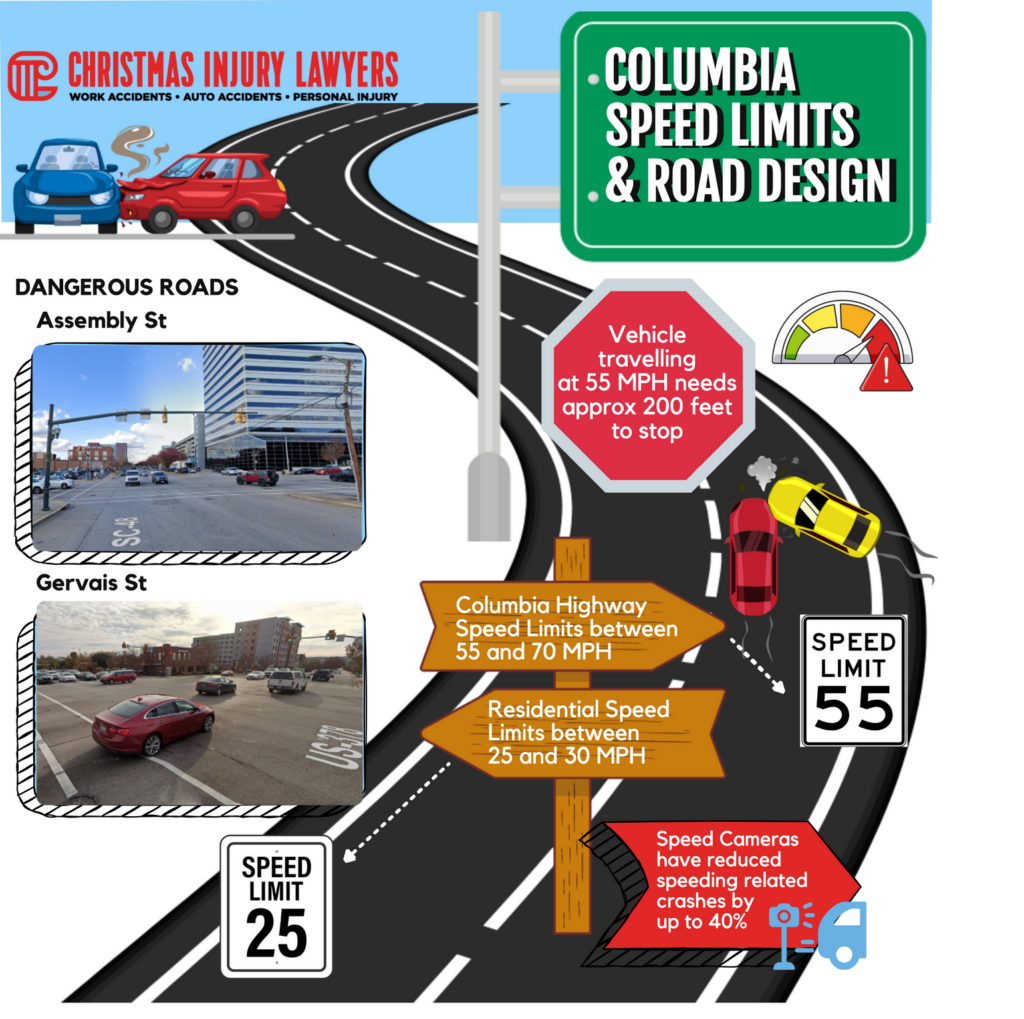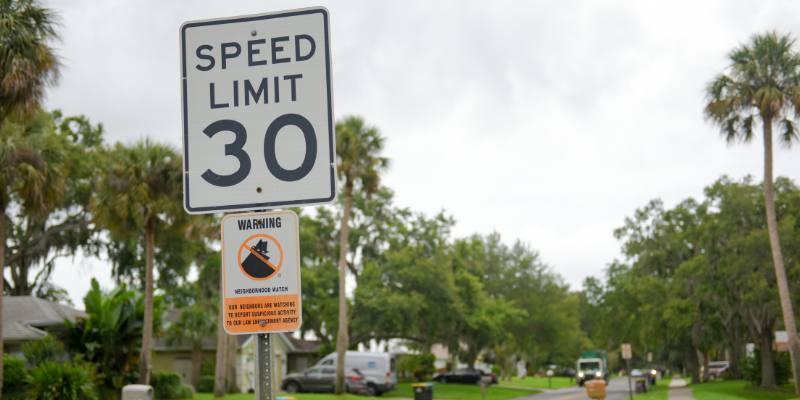In Columbia, South Carolina, car accidents remain a significant public safety issue, with many crashes attributed to a combination of speeding and poor road design. The structure of a city’s roads, along with the speed limits enforced, plays a crucial role in the overall safety of drivers, passengers, pedestrians, and cyclists. While Columbia continues to grow and expand, traffic accidents are a constant concern, particularly on roads known for poor design or excessive speeds.
This article examines how speed limits and road design contribute to car accidents in Columbia, highlighting key accident hotspots, the impact of existing speed limits, and recommendations for safer driving. We will explore how road infrastructure and speed regulations can work together to improve safety and minimize accidents.

Understanding Speed Limits and Their Impact on Road Safety
Why Speed Limits Matter
Speed limits are a critical factor in reducing road accidents. They are not arbitrarily set but are determined based on road conditions, surrounding infrastructure, and the volume of traffic. The main goal is to provide drivers with a safe maximum speed that allows them to stop or adjust quickly in the event of a hazard. Exceeding the speed limit not only increases the risk of accidents but also exacerbates the severity of collisions.
In Columbia, SC, speed limits vary depending on the area, with highways typically set between 55-70 mph, while residential and urban areas maintain lower limits of 25-35 mph. The difference in speed limits is meant to account for varying levels of pedestrian activity, traffic density, and road design. Unfortunately, when these speed limits are ignored or improperly enforced, accidents become inevitable.
The Science Behind Speed Limits
When drivers exceed the speed limit, the time they have to react to potential hazards is greatly reduced. Studies show that for every 10 mph increase in speed, the likelihood of a severe accident doubles. Moreover, higher speeds reduce a vehicle's ability to stop in time, particularly when road conditions are less than ideal, such as in wet or icy weather.
For example, if a driver is traveling at 55 mph, they will need approximately 200 feet to bring their vehicle to a complete stop. In contrast, a car moving at 35 mph will need just over half that distance. In a city like Columbia, where roads are shared with pedestrians, cyclists, and other vehicles, reducing speed limits in certain areas can significantly prevent collisions.
Speed Limits in Columbia: Key Roads and Risk Areas

Major Roads with High Accident Rates
Some of Columbia’s busiest roads are also its most dangerous due to high traffic volumes and speeding. Streets like Assembly Street, Gervais Street, and stretches of I-20 and I-26 see a higher incidence of accidents, often due to drivers exceeding speed limits or roads not designed to handle such heavy traffic.
For example, Assembly Street, which runs near the University of South Carolina, is notorious for pedestrian accidents. Its wide lanes encourage faster driving, despite speed limits that are supposed to protect the high number of students crossing the street. Similarly, Broad River Road and I-20 have become hotspots for accidents, especially during rush hour, where speeding and abrupt lane changes lead to dangerous situations.
The Role of Speed Cameras in Enforcing Speed Limits
Speed cameras are one of the most effective tools for enforcing speed limits in high-risk areas. By capturing speed violations automatically, they reduce the burden on law enforcement while encouraging safer driving behavior. In cities where speed cameras have been implemented, studies have shown a reduction in speeding-related crashes by up to 40%.
In Columbia, speed cameras could be particularly effective on streets like Assembly Street, Harden Street, and stretches of I-26 where excessive speeding is a common problem. School zones, pedestrian crossings, and intersections with high accident rates would also benefit from increased speed enforcement through automated systems.
The Impact of Road Design on Preventing Car Accidents
How Road Design Influences Driver Behavior
Road design can either promote safe driving or contribute to accidents. Features like clearly marked lanes, wide shoulders, proper signage, and smooth curves encourage safe behavior. Conversely, poorly designed roads can confuse drivers, lead to mistakes, and result in accidents. Columbia’s road network is a mix of well-planned roads and areas that need improvement, particularly in terms of pedestrian safety and traffic flow.
One key aspect of road design that influences accidents is the lane structure. Wide roads with multiple lanes can encourage drivers to speed, while roads with sharp curves or confusing signage increase the risk of collisions. For example, Assembly Street suffers from unclear lane markings, which causes frequent confusion and accidents, especially for out-of-town drivers unfamiliar with the area.
Common Road Design Flaws and Their Impact
Some of the most dangerous roads in Columbia suffer from outdated or poorly designed infrastructure. Narrow lanes, insufficient signage, and poorly planned intersections all contribute to Columbia’s accident statistics. On roads like Gervais Street, which has high traffic but inadequate road infrastructure, frequent rear-end collisions and pedestrian accidents occur due to a lack of proper road design adjustments.
A notable example of improvement is Assembly Street, where traffic calming measures, such as narrower lanes and additional crosswalks, have been added to increase pedestrian safety. These changes highlight how redesigning road infrastructure can help prevent accidents, but much work remains to be done on other busy roads in the city.
Accident Hotspots in Columbia Linked to Speed and Road Design
High-Risk Intersections and Road Sections
Columbia has several high-risk areas where both speed and poor road design contribute to frequent accidents. Intersections like Gervais Street and Harden Street and stretches of Broad River Road near I-20 are among the most dangerous. These areas see high traffic volumes, and despite posted speed limits, drivers often exceed safe speeds, contributing to rear-end collisions and pedestrian-related incidents.
How Road Design Contributes to These Hotspots
In high-risk areas like Assembly Street and Gervais Street, poor road design plays a significant role in the frequency of accidents. Roads with abrupt curves, confusing lane changes, and insufficient signage leave drivers struggling to navigate, especially when they are driving at high speeds. In areas with heavy pedestrian traffic, the combination of high speed and unclear lane markings increases the risk of accidents.
Recommendations for Improving Road Safety in Columbia
Adjusting Speed Limits Based on Road Design
In areas like Assembly Street and Harden Street, lowering speed limits could help reduce accidents, especially in pedestrian-heavy zones. Adjusting speed limits to reflect the current traffic volume and road conditions is an essential step in improving safety. For example, reducing speed limits from 35 mph to 25 mph on roads near schools or residential areas could prevent pedestrian accidents and make the streets safer for all road users.
Infrastructure Improvements to Reduce Accidents
Road redesigns, such as adding traffic circles, widening lanes, or creating better signage, can significantly reduce the risk of accidents. Studies show that traffic calming measures, like speed humps and roundabouts, are effective at lowering speeds and minimizing crashes. In Columbia, roads like Gervais Street and I-20 would benefit from improved infrastructure to make them safer for all users.
The Future of Road Safety in Columbia
Upcoming Road Projects and Speed Limit Adjustments
Columbia is continuously working on improving its infrastructure, with plans to redesign several high-risk areas. Potential road projects include improving signage on highways like I-26 and adjusting speed limits in congested urban areas like Assembly Street. These changes could have a substantial impact on reducing accidents and improving the overall safety of the city’s roads.
The Role of Technology in Enhancing Road Safety
Emerging technologies, such as AI-driven traffic lights and speed detection systems, have the potential to revolutionize road safety. Implementing these systems in Columbia could provide real-time adjustments to speed limits based on traffic conditions and enforce safer driving practices across the city. These smart systems can help prevent accidents by detecting speeding vehicles and alerting drivers to slow down before entering high-risk areas.
Conclusion
In Columbia, the combination of speed limits and road design plays a critical role in preventing car wrecks. By enforcing appropriate speed limits and redesigning hazardous roads, the city can make its streets safer for all users. Reducing accidents will require ongoing collaboration between city planners, traffic enforcement agencies, and the community. Safe driving behaviors, along with a commitment to improving road design, can significantly reduce the number of car accidents in Columbia.
FAQs
Why are speed limits important for road safety in Columbia?
Speed limits are set to match road conditions and the level of traffic to ensure safe driving. In Columbia, exceeding speed limits increases the risk of accidents by reducing the time drivers have to react to hazards.
What are some common road design flaws that lead to accidents in Columbia?
Common road design flaws in Columbia include narrow lanes, poor signage, and abrupt merging zones. These flaws, particularly in high-traffic areas like Gervais Street, contribute to accidents by confusing drivers or making it difficult to navigate safely.
Which areas in Columbia are known accident hotspots due to speed and road design?
Some accident hotspots in Columbia include intersections such as Gervais Street and Harden Street, as well as stretches of I-20 and Broad River Road. These areas experience frequent accidents due to speeding, unclear signage, and poor road design.
How can road design changes improve safety in Columbia?
Improving road design by adding features like roundabouts, clearer signage, and wider lanes can help reduce accidents in Columbia. Traffic calming measures, such as speed humps and additional pedestrian crossings, encourage slower speeds and safer driving.
How do speed cameras help reduce accidents in Columbia?
Speed cameras enforce speed limits automatically, reducing the number of speeding-related crashes. In Columbia, installing speed cameras in accident-prone areas like Harden Street or near schools could lower speeding violations and improve overall road safety by encouraging drivers to comply with speed limits.

